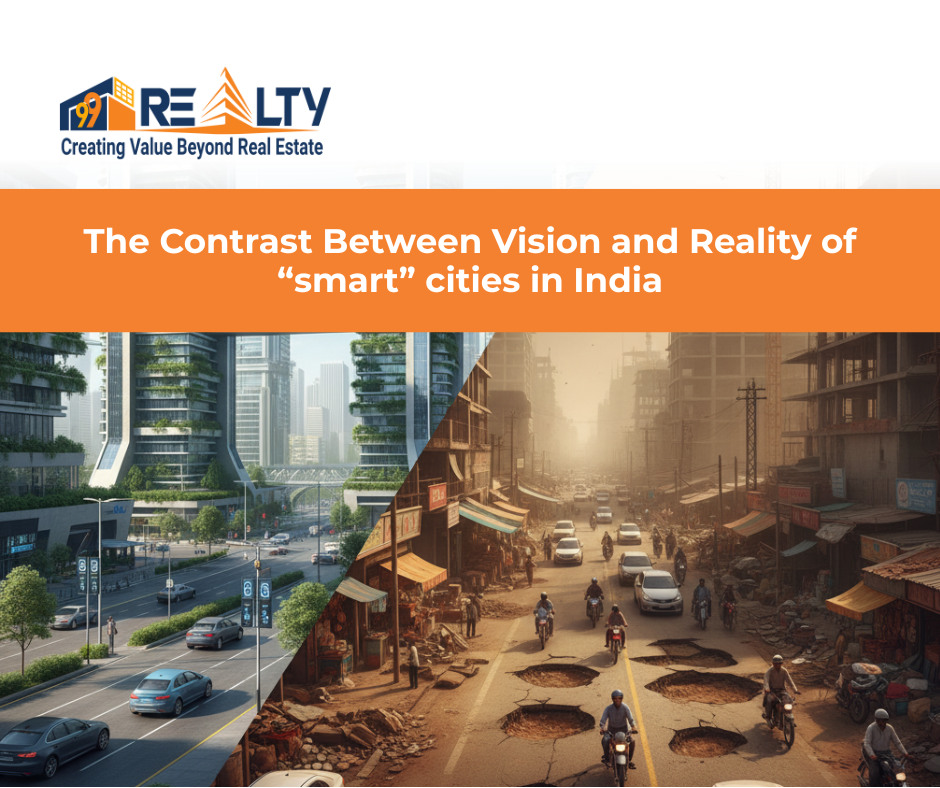When the Smart Cities Mission (SCM) was launched in 2015, it carried the promise of a new India — one that was efficient, sustainable, digitally empowered, and globally competitive. 100 cities were chosen to be the torchbearers of this urban revolution. A decade later, in 2025, it’s time to ask: Have India’s Smart Cities truly become smart — or are they just smarter versions of the old chaos?
The Vision vs. The Ground Reality
The mission’s core idea was ambitious: integrate technology, governance, sustainability, and inclusivity to transform urban spaces. Concepts like command-and-control centers, smart surveillance, e-mobility, GIS-based urban planning, waste-to-energy plants, and digital citizen services were placed at the heart of the initiative.
However, the implementation journey has been uneven. Some cities — like Pune, Surat, Indore, and Bhubaneswar — have emerged as success stories, while others struggle with stalled projects, bureaucratic bottlenecks, and financial mismanagement.
In 2025 after 10 years of the launch, the Smart Cities Mission has completed nearly 90% of its proposed projects, according to official reports. Yet, beneath this achievement lies a more nuanced truth — success varies drastically from one region to another.
The Rising Dominance of Tier 2 and Tier 3 Cities in India’s Real Estate Market
What Makes a City “Smart”?
A truly smart city isn’t defined merely by apps, sensors, or digital dashboards. It’s about:
- Efficient urban governance
- Accessible infrastructure
- Citizen-centric planning
- Resilience to climate and resource stress
- Integration of technology for transparency and sustainability
India’s urban challenges — from encroachment to poor drainage, traffic congestion to air pollution — cannot be solved merely through digitization. They require a deep restructuring of how cities grow, manage, and sustain themselves.
Major Success Stories
1. Pune – The Tech-Driven Trailblazer
Pune has become one of the finest examples of a functioning smart city, thanks to its Integrated Command and Control Center (ICCC). The city uses data analytics for real-time traffic management, solid waste monitoring, and emergency response.
Pune’s Smart Streets project has improved pedestrian zones and public transport systems, boosting its liveability index.
Land Use Zoning Demystified: What You Must Know
2. Indore – Cleanest City, Smartest Mindset
The “Swachh Bharat” champion leveraged its cleanliness mission as a backbone for smart city projects. Indore’s waste-to-energy plants, door-to-door segregation systems, and air-quality monitors are benchmark examples for other Tier-2 cities.
3. Surat – Digital Efficiency Meets Disaster Preparedness
Surat’s ICCC not only handles civic complaints but also doubles as a disaster management hub during floods. Its real-time data integration ensures transparency and efficient grievance redressal, reinforcing its reputation as one of India’s most efficiently governed urban zones.
4. Bhubaneswar – The Smart City That Set the Blueprint
Bhubaneswar’s smart city journey began with child-friendly urban design, non-motorized transport corridors, and intelligent traffic systems. It set early benchmarks by integrating digital governance with sustainable urban planning — and continues to evolve, making it a model for Eastern India.
Student Housing in Greater Noida: The Golden Gateway to Real Estate Investment Near Educational Corridors
The Regional Deep-Dive (2025): Eastern and Central India’s Smart City Reality
While metro cities in western and southern India have advanced rapidly, the Eastern and Central Indian Smart Cities — including those in Odisha, Jharkhand, Bihar, and Chhattisgarh — present a more complex picture of progress intertwined with systemic challenges.
Odisha: Bhubaneswar Leads, Others Catch Up
Bhubaneswar remains Odisha’s flagship success, with robust e-governance, real-time public transport data systems, and smart parking infrastructure. The Bhubaneswar Smart City Limited (BSCL) continues to focus on disaster resilience, particularly against cyclones, through data-driven early warning systems.
However, Rourkela and Sambalpur have seen slower progress. Rourkela’s smart city projects, such as LED street lighting and lakefront redevelopment, are operational but lack integrated ICT systems. In smaller towns, limited municipal capacity and financial constraints still hold back implementation.
Real estate impact: Bhubaneswar’s smart city zones have seen a 15–25% rise in residential property demand, especially around Patia and Chandrasekharpur, driven by IT professionals and improved infrastructure. But outside these zones, growth remains uneven.
Jharkhand: Ambitions Undermined by Administrative Gaps
Ranchi, Jharkhand’s smart city, had grand plans — a greenfield smart township, e-governance centers, and AI-powered waste management. Yet, progress remains patchy. The Ranchi Smart City project, spread over 656 acres, has completed its command center and housing complexes but faces delays in utility integration and private investment.
Challenges: Frequent leadership changes, red tapism, and inconsistent state support.
Silver lining: The Integrated Command and Control Center (ICCC) is functional and improving coordination between departments, especially in traffic management and civic complaint handling.
Real estate note: Despite limited progress, property prices in the Smart City area (Harmu, Kanke and Dhurwa regions) have increased by 10–15%, mainly due to new infrastructure and commercial activity prospects.
Bihar: Patna’s Smart City Still Crawling
Patna, one of India’s oldest cities, was selected under the Smart Cities Mission with aspirations to modernize its drainage, traffic, and governance systems. Yet, execution has lagged significantly. Issues like encroachment, outdated infrastructure, and land acquisition delays have stalled multiple projects.
Only about 60% of planned projects have been implemented as of 2025, including smart bus stops, public Wi-Fi, and surveillance networks. Patna’s ICCC is operational, but citizen awareness and data integration are limited.
Regional contrast: Gaya and Muzaffarpur have made modest gains in solid waste management but lack the digital backbone needed for scalability.
Real estate view: Investors remain cautious. Smart City zones have seen some improvement in property values (approx. 8–12% growth), but infrastructural inconsistency discourages long-term bets.
Chhattisgarh: Raipur and Bilaspur Show Promise
Raipur Smart City has emerged as a quiet achiever, focusing on digital citizen services, energy-efficient street lighting, and riverfront rejuvenation. The Integrated Traffic Management System (ITMS) and e-health kiosks reflect citizen-centric planning.
Bilaspur, on the other hand, has implemented an intelligent sewerage network and urban lake beautification under the AMRUT and Smart City frameworks.
The state’s consistent approach to data-driven governance and decentralized monitoring has made it one of the better-performing central Indian clusters.
Real estate insight: Raipur’s Naya Raipur (Atal Nagar) stands out with a 20–30% surge in commercial real estate activity, making it one of the most promising Tier-3 smart cities in India.
Pros of India’s Smart City Movement
- Digital Governance: Cities like Pune, Indore, and Bhubaneswar have embraced data dashboards and citizen apps for grievance redressal, saving time and improving transparency.
- Infrastructure Modernization: Smart roads, LED streetlights, e-buses, and integrated transport systems have improved urban efficiency in select cities.
- Sustainability Push: Waste-to-energy projects, green buildings, and solar rooftops are gradually reshaping urban energy footprints.
- Real Estate Boost: Property markets in smart zones show higher appreciation and investor interest, particularly in cities with functioning ICCCs.
- Citizen Engagement: Participatory planning models and hackathons in cities like Surat and Chandigarh have given citizens a voice in urban decision-making.
Cons and Challenges That Persist
- Uneven Implementation: Progress across the 100 cities is deeply uneven — some are near completion, while others have barely crossed 50%.
- Digital Divide: Smaller cities in Bihar, Jharkhand, and the Northeast still lack robust digital infrastructure or skilled manpower to maintain smart systems.
- Urban Inequality: Smart City zones often receive disproportionate investment, while peripheral and slum areas remain neglected.
- Maintenance Deficit: Many installed systems (like smart poles or CCTV grids) are non-functional due to poor maintenance contracts or lack of funds.
- Data Privacy Concerns: The growing use of surveillance tech raises questions about privacy and accountability.
Real Estate Impact in 2025
The Smart Cities Mission has reshaped urban property patterns.
- Commercial hubs near ICCCs and smart corridors are attracting startups, coworking spaces, and retail investors.
- Residential sectors near metro or smart transport lines are witnessing strong rental yields.
- Cities like Bhubaneswar, Raipur, Indore, and Surat have seen a 15–30% jump in real estate demand over the past five years.
However, in underperforming cities like Patna or Ranchi, speculative interest has cooled due to incomplete infrastructure and policy instability.
The Road Ahead: Beyond 2025
The Smart Cities Mission has reached its formal conclusion, but its spirit must evolve. India’s next phase of urban transformation — the “Viksit Bharat Urban 2047” roadmap — needs to build upon lessons from this decade:
- Decentralize Smart Governance — empower local bodies with financial autonomy and tech training.
- Integrate Smart Villages and Peripheries — reduce rural-urban imbalance by creating semi-urban growth hubs.
- Promote Green Urbanism — embed sustainability and climate resilience into all urban planning.
- Focus on Data Ethics — ensure data collected from citizens is used transparently and securely.
- Measure Liveability, Not Just Digitization — because true smartness lies in comfort, safety, and inclusivity.
Conclusion: Smart Cities or Smarter Governance?
The Smart Cities Mission has undeniably improved India’s urban discourse. It has made “smart governance” a national conversation, triggered innovation in local governance, and encouraged private participation.
Yet, India’s smartness cannot be measured by the number of sensors or control rooms — but by how well its cities treat their citizens. Bhubaneswar’s resilience, Indore’s cleanliness, Surat’s efficiency, and Raipur’s emerging inclusivity show that a smart city is not built overnight — it’s nurtured through consistent intent and citizen trust.
As 2025 unfolds, the story of India’s Smart Cities is still being written — in pixels, pavements, and the patience of its people.
Need Help?
Need help evaluating a property or planning your next move in the market?
Reach out to 99 REALTY – your trusted real estate partner for smarter choices.
Subscribe to get updates on our latest posts and market trends.






Join The Discussion